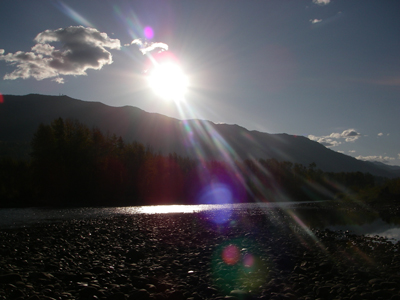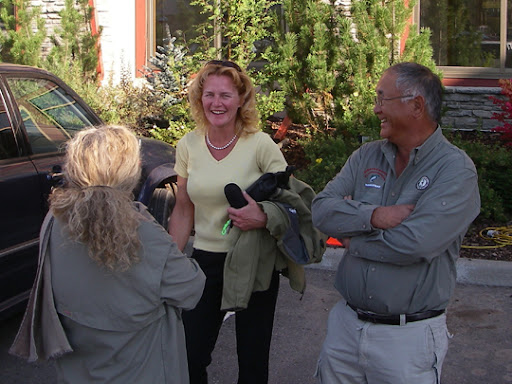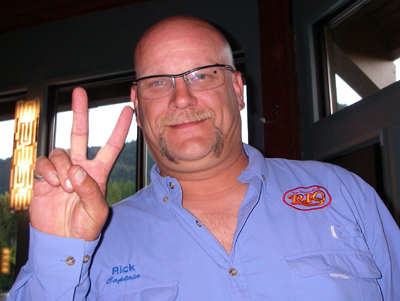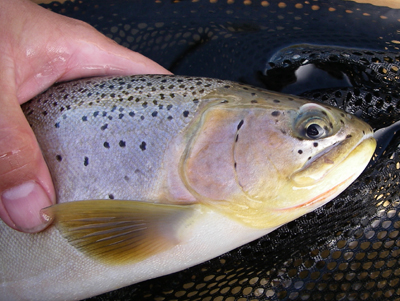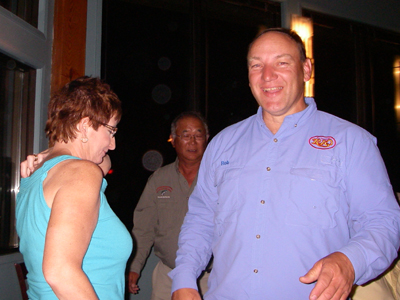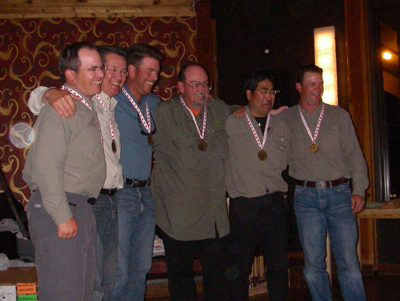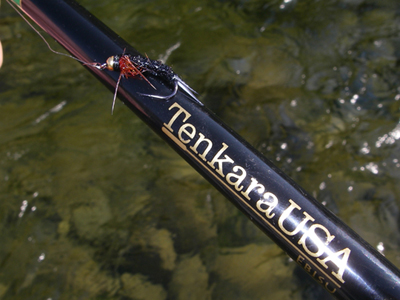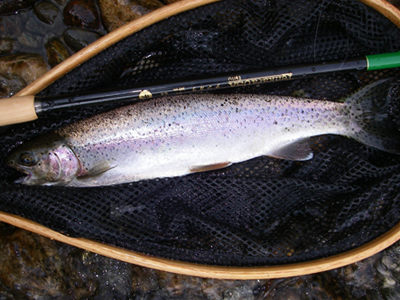 According to at least one internet source, Tenkara translates to "From Heaven". It's a nice sentiment and captures well the elegant simplicity of this style of fishing. With only rod, line, and leader it pares away the need for reels, spools and spare lines. Add a box of flies, a spool of tippet and perhaps a little floatant and you are in business.
According to at least one internet source, Tenkara translates to "From Heaven". It's a nice sentiment and captures well the elegant simplicity of this style of fishing. With only rod, line, and leader it pares away the need for reels, spools and spare lines. Add a box of flies, a spool of tippet and perhaps a little floatant and you are in business.In this piece (broken into three parts), I'm going to relate some of my experiences with using the Tenkara rod on the water--specifically casting, presentation and fish handling. Keep in mind that all my observations relate specifically to the Ebisu 6:4 12' rod, although I suspect that there will be a fair degree of carry over between the various Tenkara rods available.
Casting the Tenkara
Casting the Tenkara rod is both like and unlike casting a fly rod. The basic physics behind casting is much the same, in that there is a defined back cast to load the rod and a forward cast to increase the stored energy and propel the line through the air. Where it differs from the fly rod is that the stroke is much shorter than with a fly rod (10/12 as opposed to 10/2 o'clock) and more wrist is used--creating more of a flick in the final delivery. The traditional hand placement is also different, with the index finger laying parallel to the rod and "pointing" toward the tip.
I've tried several lines and tapers since purchasing my 12' (3.7 m) Ebisu model--a furled mono Tenkara line, a clear intermediate poly-tip, a length of level running line (with and without a tapered leader), and finally various sections of tapered fly line in a range of line weights.
I originally ordered rod with the recommended 10' 6" (3.2 m) furled mono line. After a few perfunctory flicks in the backyard, I took the rod to a local stream for an on the water test. My casting strokes were a little awkward at first. I tried the recommended 10/12 o'clock cast but I found the forward stroke didn't really turn the line over well. However, increasing both the speed of the back cast slightly and the pause at the twelve o'clock position helped significantly. If I was able to load the line in the water prior to the back cast as I would on a spey cast, the results were better still. The only casting issue with this line is that the line lacks a measure of stiffness needed to really turn over larger flies--a minor issue because you would rarely end up using this rod for casting chernobyl ants and the like.
The next "line" I tried was assembled using a tapered 5' (1.5 m) clear neutral density Airflo poly-tip, attached to a 6' (1.8 m) section of 8lb Berkley Vanish. I found that the heavy tapered tip was enough to turn over the stiff fluorocarbon section while allowing the rod to load more easily than with the furled line. This configuration worked particularly well for weighted flies over the short casting stroke of the rod. Of the various configurations tried, I found this the most useful for czech nymphing.
Looking for a little extra distance for dry fly and streamer presentations, the third configuration I tried was an 11' length of narrow floating running line looped at either end. I used this alone and in combination with the poly-tip mentioned above. The former configuration worked poorly but the addition of the tip made casting very smooth, loading the rod easily and laying the line out straight and quietly on a few clear streams that I fish. The only drawback was that the extra length made landing fish much more difficult and there was loss of intimacy and feel that is the real benefit of this rod. I suspect a shorter running line in conjunction with the tapered tip would probably give better results and I may try this in future.
The last series of lines tried were taken from traditional fly lines: two 15' (4.5 m) tips from a 5 and 8 wt multi-line set-up and a 15' section cut from a 2wt floating line. As expected the heavy tips went far beyond the limits of what the rod could handle. In both cases I was able to cast these lines, but the results were far from pretty--with rod heavily over-flexed and the delivery both awkward and heavy. The 2wt tapered line proved to be a completely different story. Casting was both effortless and smooth. Dry flies and soft-hackles turned over perfectly and alighted gently on the water. Heavy artillery also fired well with this line including medium sized streamers. However, at 15' the line was too long to control properly particularly with regard to fish handling, and as with the level line/tip combination contributed to a loss of intimacy and feel. Cutting the line first to 13' and finally to 11' (removing sections from the butt end) returned line control and sensitivity.
Summary:
Of the lines tried, the furled tenkara line, polytip and 2wt floating taper all proved adequate for casting with the 12' Ebisu. However, I feel that the 11' two weight tapered fly line was most appropriate for the rod. Sufficiently heavy enough to load the rod easily, this line can be adapted for the widest range of uses--including dry fly, soft hackle and streamer work. I would still give the edge to the polytip line for czech nymphing in deeper flows where the floating taper can interfere with presentation, but overall the floating tip is the most versatile.
Next time I discuss the Tenkara rod it will be with respect to presentation. Until then good fishing everyone (I'm off to look for coho and cutthroat).
Aaron






